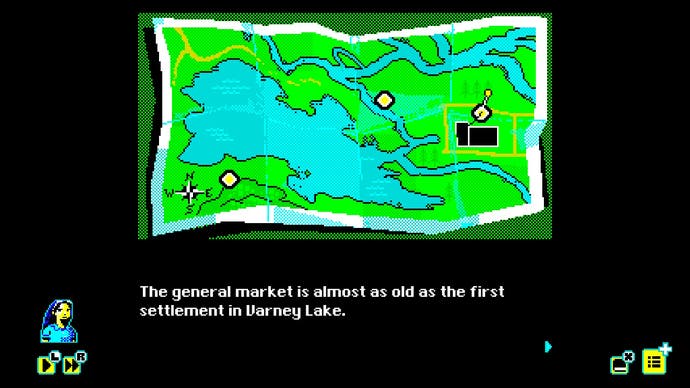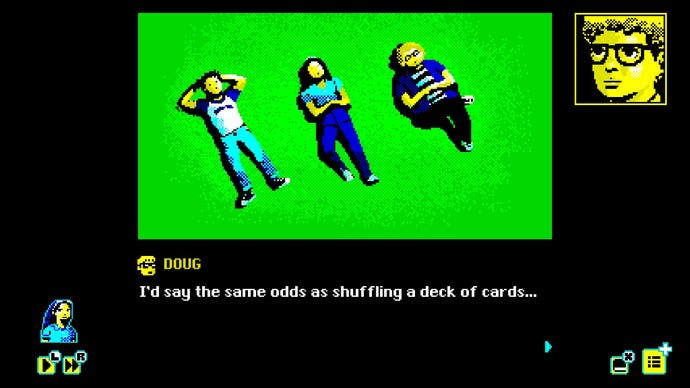Varney Lake review - another haunted CGA classic
Nostalgiaaaargh!
There's a moment in Varney Lake where you meet the vampire. It's early summer, 1954, and a few friends are working out what to do with the lazy days that stretch ahead. They come across a shack and wander in. And there they meet the vampire.
It's a fascinating moment, and one I shouldn't spoil. What I will say, though, is that I've played this moment again and again and I'm mesmerised by how it's handled. I'm mesmerised by all the surprising, delicate choices that have been made in the staging. The vampire is frightening, but the scene is not purely frightening. It's filled with fascination and care, by memories the characters have of the grown-ups in their lives and how they tend to react to things. And there's that brilliant juxtaposition, the dark of the shack, the bright summer sun outside. And this juxtaposition is heightened by the fact that this scene, this present, is also part of the past. It is lit by the bright, sometimes blinding sun of memory.
Varney Lake is the follow-up to Mothmen 1966, which means it is a Pixel Pulp made by an Argentinian micro-studio who love creepy things, cryptids, horror, and pulp as a sensibility, as a process for making art quickly as well as pulp as a genre or rogue's gallery of themes. Like Mothmen 1966 Varney Lake comes across as a haunted CGA game from the early 1990s PC gaming scene. It's a visual novel, with decisions that play out as you make choices through a text selection interface. The visuals are an absolute thing of glory: lurid, playful, sometimes sharply realistic, all delivered in just a handful of carefully selected and paired colours and filled with graphical noise, pixel cross-hatching, the mimeo-thick lines of cheap old Mad Magazine printing.
Those colours! Varney Lake is a story about a summer in the 1950s and how it impacts the lives of three friends. So it plays out in 1954 and also a couple of decades later - the early eighties - as some of the characters are drawn back together to pick over what happened. The eighties sections are all urban drizzle, and the colours chosen are primarily dark blues and a sort of toxic green. Everything feels claustrophobic and slick with rain. These two colours working together make the present feel sodden, as disappointed men and women try to work out what went wrong with everything and if it is too late.
But 1954 is largely blinding yellow and white and blue: a landscape of endless summer holiday promise where even the nights are filled with bright points. And while the 1980s sequences felt at times quite close to Mothmen 1966 - there's a shared character, and a shared focus on understanding what has happened - the 1954 section is, well, I'm still taking it in.



I'm not a huge replayer of games in general, but I have re-read Varney Lake at least three times by this point. Partly I'm trying to see different outcomes and unlock different hidden scenes. Partly I am trying to understand the true spine of the narrative that runs through the game. But really I am drawn back to explore the boundaries of the 1954 sections, where there's a tale of three friends who meet a vampire, sure, but also so much else. There's a sense of Peanuts to proceedings, weirdly enough. You might choose to lay on your backs on the grass and spot shapes in the cloud - a classic Peanuts riff, and a classic moment of disappointment for Charlie Brown, who sees a ducky and a horsey while Linus sees the Pilgrim arriving in the new world or some such.
You might choose that. Or you might choose to go fishing. You might try to make a but of money. Pick something to do each day. And then, only then, once night falls, will you return to the vampire.

All of these things are puzzles to work through, but they don't always feel like it. Sometimes, they simply feel like things to do over the summer. This slight shapelessness - and I'm sure it's not actually shapelessness at all really - but this sense of freedom at the heart of Varney Lake feels to me like its absolute strongest point. It's completely fascinating. The game is giving me a summer holiday to make what I will of, and then it's throwing in elements that I cannot change that will warp events in certain directions and then - then! - it's leaving me to the memories of what I have created in co-authorship with the game itself. This is how it strikes me, anyway. It allows me to have a hand in constructing memories which I will then have to sort through with the characters.
To say more would be spoiling things, I think. And, in truth, after the next re-reading, I may feel drastically different about the events of the game and the structure of the game anyway. Just know this: if you're coming to Varney Lake from Mothmen, you'll have a lot of the atmosphere you loved, a lot of the intrigue and pulpy art, and even a new Solitaire variant at the heart of it all. But there's something else here too, another presence, and one that I am still enjoying the pleasures of untangling for myself.



